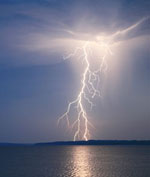ThunderstormsBack to Hazards Directory  Florida is the thunderstorm capital of the United States. Thunderstorms are attributed to hot, wet air close to the ground combined with an unstable atmosphere. Often the resulting thunderstorms occur during afternoons — June through September — and can be as brief as a few minutes or as long as a couple of hours, but seldom longer. Before Severe Weather Arrives: Have at least a 5 day Disaster Supplies Kit assembled. Purchase a NOAA Weather Radio to monitor severe weather. If you do not have a weather radio, stay tuned to a local radio or television station. Learn what Thunderstorm Watch and Thunderstorm Warning mean so that you clearly understand the risk to your family and your community. “Thunderstorm Watch” means conditions are favorable for thunderstorms to produce wind gusts to 58 mph or stronger, or hail to 3/4 inch or larger in the watch area. These watches are issued for 4 to 6 hours at a time and can cover several counties. Stay informed, watch the sky, and take cover if a severe thunderstorm is approaching. “Thunderstorm Warning” means a severe thunderstorm has been detected by radar or by a trained spotter. Take cover if you are in or near the severe thunderstorm area. Protect your belongings from power surges, which can damage electrical equipment, by using point-of-use or point-of-entry surge suppressors. Point-of-use surge suppressors only help protect the items that are directly connected to them, while point-of-entry surge suppressors protect against surges from utility power lines as they enter the home/business. Contact your electrical utility company for more information on what method of protection is best for you.
During Thunderstorms and Lightning storms: Postpone outdoor activities if thunderstorms are imminent. Avoid touching metal. Utility lines and metal conduct electricity. Avoid using the telephone or any electrical appliances. Avoid taking a bath or shower, or running water for any purpose. If you feel your hair stand on end, drop to the ground in a crouched position with your hands on your knees. Do not lie flat on the ground. Avoid trees and telephone poles. If surrounded by trees, move under a growth of smaller trees. Stay away from water during a thunderstorm. Water conducts electricity. Avoid open water and metal equipment (e.g. golf carts/clubs, tractors, fences, bicycles, umbrellas). Keep several yards away from other people. In open areas, move towards the lowest area. Watch for flash flooding. Stay indoors and away from windows during a storm. Learn first-aid and CPR. Many people struck by lightning can be revived if quick action is taken. If you are affected by a lightning strike, see a physician immediately. Remember, if you can see lightning or hear thunder you are close enough to be struck by lightning! Find shelter in a building or car. Keep car windows closed and avoid convertibles.
|